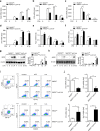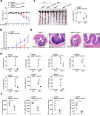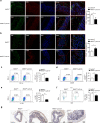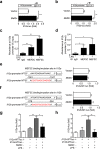MEF2C promotes M1 macrophage polarization and Th1 responses
- PMID: 35194174
- PMCID: PMC8975968
- DOI: 10.1038/s41423-022-00841-w
MEF2C promotes M1 macrophage polarization and Th1 responses
Abstract
The polarization of macrophages to the M1 or M2 phenotype has a pivotal role in inflammation and host defense; however, the underlying molecular mechanism remains unclear. Here, we show that myocyte enhancer factor 2 C (MEF2C) is essential for regulating M1 macrophage polarization in response to infection and inflammation. Global gene expression analysis demonstrated that MEF2C deficiency in macrophages downregulated the expression of M1 phenotypic markers and upregulated the expression of M2 phenotypic markers. MEF2C significantly promoted the expression of interleukin-12 p35 subunit (Il12a) and interleukin-12 p40 subunit (Il12b). Myeloid-specific Mef2c-knockout mice showed reduced IL-12 production and impaired Th1 responses, which led to susceptibility to Listeria monocytogenes infection and protected against DSS-induced IBD in vivo. Mechanistically, we showed that MEF2C directly activated the transcription of Il12a and Il12b. These findings reveal a new function of MEF2C in macrophage polarization and Th1 responses and identify MEF2C as a potential target for therapeutic intervention in inflammatory and autoimmune diseases.
Keywords: Inflammation; Interleukin-12; Macrophage polarization; Myocyte enhancer factor 2C; T helper type 1 response.
© 2022. The Author(s), under exclusive licence to CSI and USTC.
Conflict of interest statement
The authors declare no competing interests.
Figures








References
-
- Diskin C, Ryan TAJ, O’Neill LAJ. Modification of proteins by metabolites in immunity. Immunity. 2021;54:19–31. - PubMed
Publication types
MeSH terms
Substances
LinkOut - more resources
Full Text Sources
Research Materials

